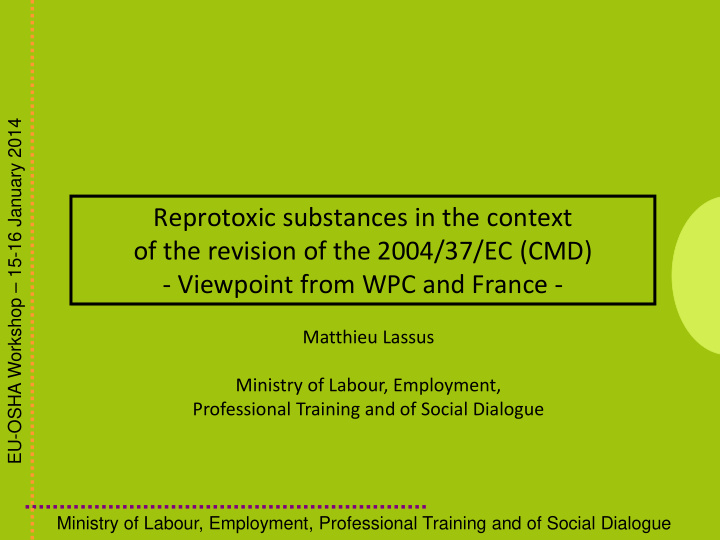



EU-OSHA Workshop – 15-16 January 2014 Reprotoxic substances in the context of the revision of the 2004/37/EC (CMD) - Viewpoint from WPC and France - Matthieu Lassus Ministry of Labour, Employment, Professional Training and of Social Dialogue Ministry of Labour, Employment, Professional Training and of Social Dialogue
ACSH’s opinion(s) The Commission has decided that the CMD should be amended. EU-OSHA Workshop – 15-16 January 2014 The WPC has submitted several draft opinions for endorsement of the Advisory Committee on Safety and Health at Work (ACSH). Opinion of may 2013 (Doc. 727/13) explains how the WPC has considered whether CMD should be extended to reprotoxic substances Ministry of Labour, Employment, Professional Training and of Social Dialogue
Main specific comments (1) From the Workers Interest Group EU-OSHA Workshop – 15-16 January 2014 rationale for inclusion in the CMD - CAD is « far from satisfactory [and expanding the CMD] would improve prevention for workers of both sexes in general and for pregnant workers in particular ». - Coherency with SVHC in REACH which include all CM&R substances. « This can be seen as a regulatory simplification and it would also increase the synergies between the two pieces of legislation ». - « Six EU countries (Austria, Czech Republic, Finland, France, Germany, The Netherlands) have already widened the Carcinogens Directive’s scope to substances toxic to reproduction when implementing it into national law. [And] it is worth mentioning that the European Parliament in its report adopted in December 2011 is also calling for an enlargement of the scope of 2004/37/EC to include substances toxic for reproduction ». http://www.europarl.europa.eu/sidesSearch/search.do?type=REPORT&lan guage=EN&term=7&author=96868» Ministry of Labour, Employment, Professional Training and of Social Dialogue
Main specific comments (2) From the Employers Interest Group : EU-OSHA Workshop – 15-16 January 2014 Rationale for inclusion in the CAD and not in the CMD - CMD « has been specifically conceived for dealing with carcinogens for which no safe exposure level can be derived. [...] For reprotoxic substances a “safe” exposure limit can be set in many cases ». - CAD is the current and sufficient « frame to operate in and to ensure that the exposure to these types of substances can be addressed if deemed appropriate ». From the Governmental Interest Group : The GIG has been neutral in this opinion and has shared only the view expressed in the common part. Ministry of Labour, Employment, Professional Training and of Social Dialogue
Within the GIG : view from France Flashback in the 90’s… EU-OSHA Workshop – 15-16 January 2014 - 90/394/EC on C agents has been extended to M agents by the 99/38/CE - The DSD and DPD evolved in the same decade. In this context, the French transposition of the “new C+MD” (decree from 1st of February 2001) proposed a global CMR approach (13 years ago…). - With such regulatory scheme there is less gender discrimination at the workplace and it contributes to a global solution for prevention of a global risk for the general and worker population. - This is (still) coherent with all other pieces of national or european legislation referring classification criteria from (DSD/DPD and) CLP regulation : OSH legislation, REACH, biocidal/phytopharmaceutical/cosmetics products regulations, etc. Ministry of Labour, Employment, Professional Training and of Social Dialogue
Consensus Main key points from the report for DG-EMPL : EU-OSHA Workshop – 15-16 January 2014 - Based on annex VI of CLP : near 100/151 (2/3) of the CMR are R only - Non-binding guidance and awareness raising activities are appropriate options for reducing the health risk with a best cost-benefit ratio. - The impact assessment of the consultant is not sufficient to exclude the legal option which highlighted benefits in terms of reduction in workers’ exposure in Germany and France. Common statements in the ACSH’s opinion : - Effective control of exposure to reprotoxic substances is a priority issue. - However, at this stage, “ it is not yet possible to agree on the most appropriate approach at EU level. This is because of divergent views on the concept, purpose and scope of CAD and CMD, including how to regulate substances for which a scientific threshold can be established ”. Ministry of Labour, Employment, Professional Training and of Social Dialogue
Work in progress Several scientific, technical and practical efforts could be made EU-OSHA Workshop – 15-16 January 2014 independently of the legal vector in the OSH legislation. “[…] ACSH encourages the Commission services, together with the WPC: 1) to identify priority reprotoxic substances for evaluation by SCOEL and to bring forward proposals for OELs as quickly as possible to further improve the protection of worker health; and 2) to develop guidance to help employers and workers. The guidance should address both fertility and developmental aspects of reprotoxic substances. In addition, as a large percentage of exposures to reprotoxic substances are to inorganic lead and lead compounds, and as the existing EU binding occupational and biological limits for these substances are known to be not sufficiently protective of health, these limits should be reviewed and amended as soon as possible. ” And we have also an european (and national…) strategy on EDs in progress… Ministry of Labour, Employment, Professional Training and of Social Dialogue
EU-OSHA Workshop – 15-16 January 2014 Thank you for your attention ! Matthieu LASSUS Bureau des risques chimiques, physiques et biologiques Direction générale du Travail Ministry of Labour, Employment, Professional Training and of Social Dialogue
Recommend
More recommend